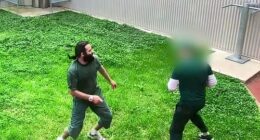Share this @internewscast.com
RIVERSIDE, Calif. (BLOOM) — As the prevalence of manipulated videos continues to spread misinformation and create public distrust, researchers at the University of California, Riverside, have developed an innovative artificial intelligence tool designed to identify forged content, whether it’s a face swap or a fully synthetic video.
Created in partnership with Google, this system is known as the Universal Network for Identifying Tampered and synthEtic videos, or UNITE. Unlike most deepfake detectors that primarily focus on facial features, UNITE examines entire video frames, including backgrounds and movement patterns, to identify manipulation.
“Deepfakes have evolved,” noted Rohit Kundu, a UC Riverside doctoral student and the lead author of the study. “They have gone beyond simple face swaps. Now, people are using advanced generative models to make completely fake videos—everything from faces to backgrounds. Our system is designed to detect all of these manipulations.”
Kundu developed the tool alongside Amit Roy-Chowdhury, professor of electrical and computer engineering and co-director of the Riverside Artificial Intelligence Research Institute, and a team of Google scientists. Their findings were presented at the 2025 Conference on Computer Vision and Pattern Recognition in Nashville, Tenn.
The model is built on a transformer-based architecture and uses a technique called “attention-diversity loss,” which prompts the AI to monitor multiple visual regions instead of focusing on just one subject. It’s trained on a wide range of synthetic content—including text-to-video and image-to-video generations—formats that often evade traditional detection methods.
Kundu said the collaboration with Google, where he interned, gave the team access to powerful computing resources and expansive training datasets.
“It’s scary how accessible these tools have become,” Kundu said. “Anyone with moderate skills can bypass safety filters and generate realistic videos of public figures saying things they never said.”
UNITE is still in development, but researchers say it could soon be a critical line of defense for newsrooms, social media platforms, and fact-checkers.
“People deserve to know whether what they’re seeing is real,” Kundu said. “And as AI gets better at faking reality, we have to get better at revealing the truth.”
For more information, visit news.ucr.edu.















